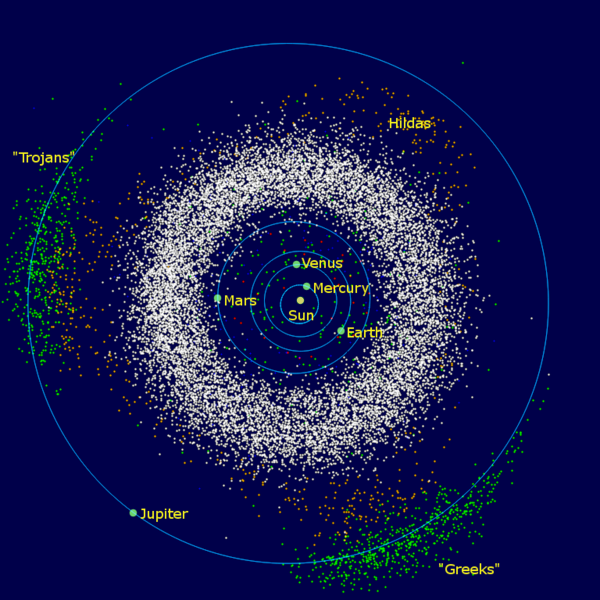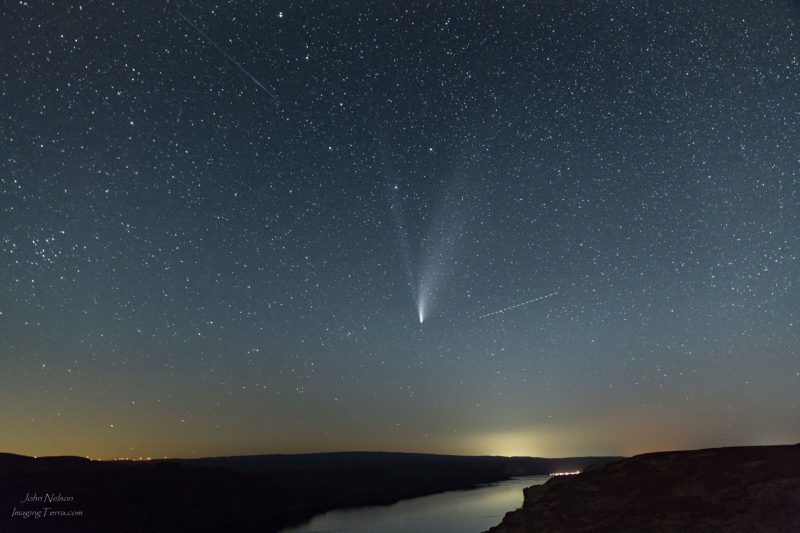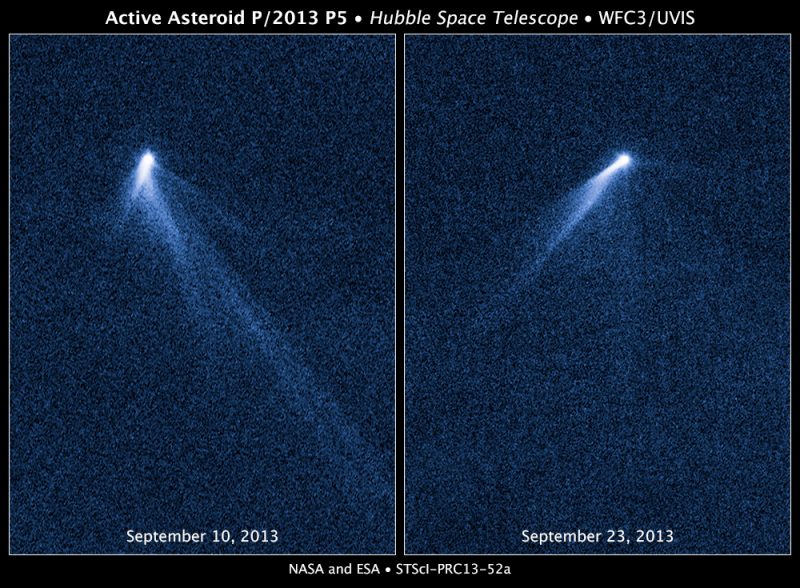
Comets and asteroids usually differ in composition
Comets and asteroids are both members of our solar system. Both were born from the same great primordial cloud of dust and gas that created Earth and the other planets, 4.5 billion years ago. But comets and asteroids have differences. They can usually (but not always) be distinguished by what they’re made of, and by where they’re found in the solar system. Both are small bodies orbiting the sun. But it’s usually easy to tell them apart.
Asteroids
Asteroids mostly reside in the asteroid belt, a wheel-shaped region of our solar system between the fourth planet, Mars, and the fifth planet, Jupiter. NASA explains:
The majority of known asteroids orbit within the asteroid belt between Mars and Jupiter, generally with not very elongated orbits. The belt is estimated to contain between 1.1 and 1.9 million asteroids larger than 1 kilometer (0.6 mile) in diameter, and millions of smaller ones. Early in the history of the solar system, the gravity of newly formed Jupiter brought an end to the formation of planetary bodies in this region and caused the small bodies to collide with one another, fragmenting them into the asteroids we observe today.
So asteroids are little bodies that might have gone into making another planet, but didn’t. Their compositions are reminiscent of the composition of Earth itself; they’re made of metals and rocky materials.
Also, asteroids have lumpy potato-like shapes.

How are asteroids named?
The International Astronomical Union has the responsibility for assigning asteroid names. The first asteroids discovered were given names from ancient mythology, while newer names can honor anything from people (such as 3505 Byrd) to bands (8749 Beatles).

Comets
In contrast to asteroids, most comets come from beyond the orbit of Pluto, in a region of the solar system called the Oort Cloud. Comets tend to have much more elongated orbits than asteroids, sometimes reaching so far out into the outer reaches of our solar system that passing stars can perturb these small bodies. When that happens, a comet may plunge inward toward our sun. Comets are icier than asteroids because they formed in the deep freeze of the outer solar system. They’re composed of rock and ice, earning them the nickname dirty snowballs.
It’s when comets sweep in close to the sun that they produce their characteristic gas and dust tails.
Comets are named for their discoverers.

Of course, there are oddities with both comets and asteroids
Not all comets and asteroids fall into the neat categories mentioned above. Besides comets that come from the Oort Cloud, another group of comets orbit much closer to the sun. They are short-period comets and have orbital periods less than 200 years. Most short-period comets move in orbits that are the same direction as the planets. One notable exception to this is the most famous comet of them all, Halley’s Comet.
Both comets and asteroids are parent objects to meteor showers
Here’s another strange twist on the distinctions that exist between comets and asteroids. That is, comets are the usual parent objects for our annual meteor showers. Comets are flimsy objects, and, when they come close to the sun, they often leave behind a trail of icy debris. Every year, Earth plows through many old comet paths. This cometary debris enters our atmosphere, and that’s why we experience meteor showers.
For example, the Orionids and Eta Aquariids are both showers made from debris left behind by Halley’s Comet. Comet Tempel-Tuttle is the source of the Leonid meteor shower. But not all meteor showers stem from comets. The Geminid meteor shower – seen every December – has a mysterious object called 3200 Phaethon as its source. This object is sometimes called a rock-comet; that’s because in many ways, it’s like an asteroid-comet hybrid.
3200 Phaethon, the weird asteroid with a tail, isn’t the only object blurring the border between asteroids and comets. The Hubble Space Telescope captured an image of asteroid 311P/PANSTARRS and revealed it has six tails! So this strange asteroid is also a main-belt comet, and as a bonus it may have a satellite in orbit around it.

Bottom line: Most asteroids are rocky bodies that lie within the asteroid belt while comets are dirty snowballs from the Oort Cloud, with some objects acting like a hybrid of these two types.
The post Comets and asteroids: What’s the difference? first appeared on EarthSky.
from EarthSky https://ift.tt/pYHMzqm

Comets and asteroids usually differ in composition
Comets and asteroids are both members of our solar system. Both were born from the same great primordial cloud of dust and gas that created Earth and the other planets, 4.5 billion years ago. But comets and asteroids have differences. They can usually (but not always) be distinguished by what they’re made of, and by where they’re found in the solar system. Both are small bodies orbiting the sun. But it’s usually easy to tell them apart.
Asteroids
Asteroids mostly reside in the asteroid belt, a wheel-shaped region of our solar system between the fourth planet, Mars, and the fifth planet, Jupiter. NASA explains:
The majority of known asteroids orbit within the asteroid belt between Mars and Jupiter, generally with not very elongated orbits. The belt is estimated to contain between 1.1 and 1.9 million asteroids larger than 1 kilometer (0.6 mile) in diameter, and millions of smaller ones. Early in the history of the solar system, the gravity of newly formed Jupiter brought an end to the formation of planetary bodies in this region and caused the small bodies to collide with one another, fragmenting them into the asteroids we observe today.
So asteroids are little bodies that might have gone into making another planet, but didn’t. Their compositions are reminiscent of the composition of Earth itself; they’re made of metals and rocky materials.
Also, asteroids have lumpy potato-like shapes.

How are asteroids named?
The International Astronomical Union has the responsibility for assigning asteroid names. The first asteroids discovered were given names from ancient mythology, while newer names can honor anything from people (such as 3505 Byrd) to bands (8749 Beatles).

Comets
In contrast to asteroids, most comets come from beyond the orbit of Pluto, in a region of the solar system called the Oort Cloud. Comets tend to have much more elongated orbits than asteroids, sometimes reaching so far out into the outer reaches of our solar system that passing stars can perturb these small bodies. When that happens, a comet may plunge inward toward our sun. Comets are icier than asteroids because they formed in the deep freeze of the outer solar system. They’re composed of rock and ice, earning them the nickname dirty snowballs.
It’s when comets sweep in close to the sun that they produce their characteristic gas and dust tails.
Comets are named for their discoverers.

Of course, there are oddities with both comets and asteroids
Not all comets and asteroids fall into the neat categories mentioned above. Besides comets that come from the Oort Cloud, another group of comets orbit much closer to the sun. They are short-period comets and have orbital periods less than 200 years. Most short-period comets move in orbits that are the same direction as the planets. One notable exception to this is the most famous comet of them all, Halley’s Comet.
Both comets and asteroids are parent objects to meteor showers
Here’s another strange twist on the distinctions that exist between comets and asteroids. That is, comets are the usual parent objects for our annual meteor showers. Comets are flimsy objects, and, when they come close to the sun, they often leave behind a trail of icy debris. Every year, Earth plows through many old comet paths. This cometary debris enters our atmosphere, and that’s why we experience meteor showers.
For example, the Orionids and Eta Aquariids are both showers made from debris left behind by Halley’s Comet. Comet Tempel-Tuttle is the source of the Leonid meteor shower. But not all meteor showers stem from comets. The Geminid meteor shower – seen every December – has a mysterious object called 3200 Phaethon as its source. This object is sometimes called a rock-comet; that’s because in many ways, it’s like an asteroid-comet hybrid.
3200 Phaethon, the weird asteroid with a tail, isn’t the only object blurring the border between asteroids and comets. The Hubble Space Telescope captured an image of asteroid 311P/PANSTARRS and revealed it has six tails! So this strange asteroid is also a main-belt comet, and as a bonus it may have a satellite in orbit around it.

Bottom line: Most asteroids are rocky bodies that lie within the asteroid belt while comets are dirty snowballs from the Oort Cloud, with some objects acting like a hybrid of these two types.
The post Comets and asteroids: What’s the difference? first appeared on EarthSky.
from EarthSky https://ift.tt/pYHMzqm

Aucun commentaire:
Enregistrer un commentaire